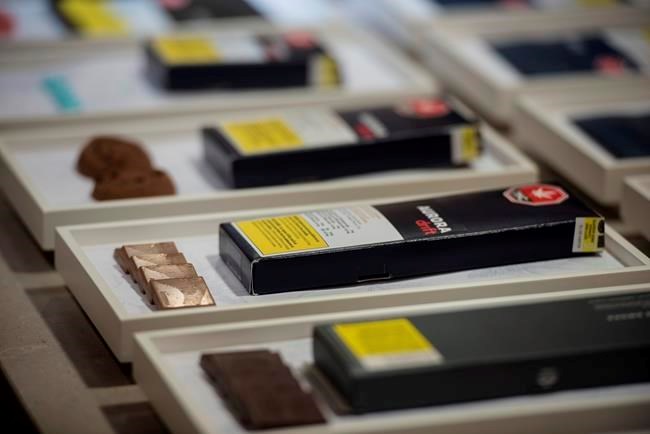TORONTO — In a bid to help retailers compete with the illicit pot market, the Ontario Cannabis Store will lower its price margins this fall — but its chief executive warns the move won't solve all the industry's woes.
The OCS, which is responsible for distributing weed to retailers after it's produced, announced the change Thursday and said it would be implemented by September.
The OCS estimates its reduced margins will put $35 million back in the hands of licensed pot companies this fiscal year and $60 million in the 2024 fiscal year. However, these companies aren't required to pass along those savings by lowering their prices.
Any break on costs is likely to be welcome in the industry, which Canopy Growth Corp., one of Canada's most prominent pot companies, said has fallen well below the $7 billion valuation that was projected around the time of legalization.
However, two industry sources told The Canadian Press the average mark-up will decline to 25 per cent from 28 per cent, though the amount varies as the provincial distributor is moving to fixed amounts depending on the product category. The biggest margin reductions will come in the vapes, edibles and beverage categories with more modest decreases to flower, pre-rolls and concentrates.
The Canadian Press is not identifying the sources because they were not authorized to disclose the information.
Asked whether decreases will average three per cent, OCS chief executive David Lobo declined to give specifics but said that amount would "be in that ballpark."
The margin drop was largely triggered by the strength of the illicit pot market, which still made up 43 per cent of Ontario's cannabis market last March. In June of 2020, illicit sellers made up 75 per cent of the Ontario market.
Statistics Canada said a gram of legal cannabis cost $10.29 on average in 2019, the year after recreational cannabis was legalized in Canada (more recent prices were not available). At that time, a gram of weed bought through the illicit market cost $5.96.
Legal weed prices have fallen dramatically in recent years, with the OCS advertising several brands of flower for between $3.50 and $4.50 per gram on Thursday.
The OCS decided to address its margins after talking to licensed producers and reviewing data, Lobo said.
"It just felt like a great time that hey, we could use some of our scale, adjust our margin to give back a bit of breathing room to the sector."
But he cautioned against seeing the move as a cure-all for an industry that has spent much of the time since cannabis was legalized in 2018 engrossed in layoffs, facility cuts and restructurings.
"It will have an impact, but I don't think it is the only fix or an improvement to the marketplace that's needed."
Pot producers, which are mostly unprofitable, have blamed illicit sellers, along with excise taxes and OCS margins, for a series of cuts to jobs, facilities and products they have made over the last few years.
In the last week alone, Canopy said it would lay off 800 workers as part of a transformation plan that will also include the closure of a former Hershey chocolate plant in Smiths Falls, Ont. it took over and the consolidation of some of its cultivation operations.
Then, licensed producer SNDL Inc. announced a layoff impacting 85 employees at its Olds, Alberta facility that it said would deliver $9 million in savings.
To combat further cuts and remain competitive with the illicit market, licensed producers have been slashing their prices, but complain it is eating into their profits.
"We are very aware of price compression in the marketplace," Lobo said.
"That is part of a competitive marketplace, but we do caution that going lower on price alone doesn't necessarily mean we're going to convert more people over from the legal market."
With prices in decline and profitability targets under pressure, licensed producers and retailers were pleased to hear about the OCS's margin reduction.
"This announcement will allow producers to better compete with the illicit market, particularly when it comes to dried flower," said Charlie Bowman, chief executive and president of licensed producer Hexo Corp. in an email.
"This is an important step in giving Canada’s cannabis companies the upper hand over illegal producers."
However, the OCS's changes won't come into effect until later in the year to give both the distributor and licensed producers time to consider changes to existing products and their release schedules.
But some have already reviewed the margin reductions and decided not to change their prices as a result.
"The OCS deserves credit for implementing these important changes which will accelerate industry sustainability and ultimately profitability as we intend to hold our prices due to the already highly competitive product pricing within the sector," said Canopy chief executive, in an emailed statement.
High Tide Inc., the cannabis company behind Canna Cabana stores, was equally pleased with the OCS's decision, but said "more needs to be done especially by the federal government, to ensure the sustainability of Canada’s legal cannabis sector."
"We look forward to further discussions with the OCS, regulators, as well as the federal and provincial governments about additional concrete measures that can be taken to ensure our industry continues to grow and create jobs while protecting public health.”
This report by The Canadian Press was first published Feb. 16, 2023.
Companies in this story: (TSX: WEED)
Tara Deschamps, The Canadian Press




